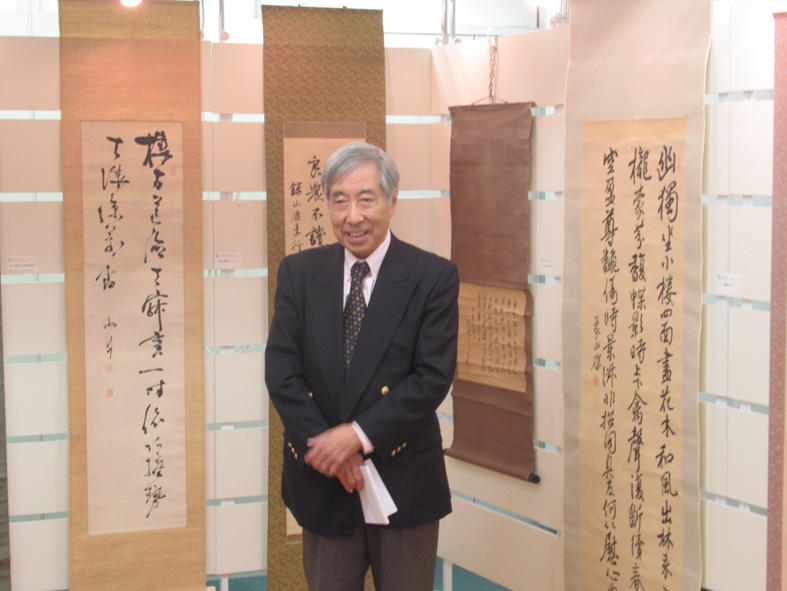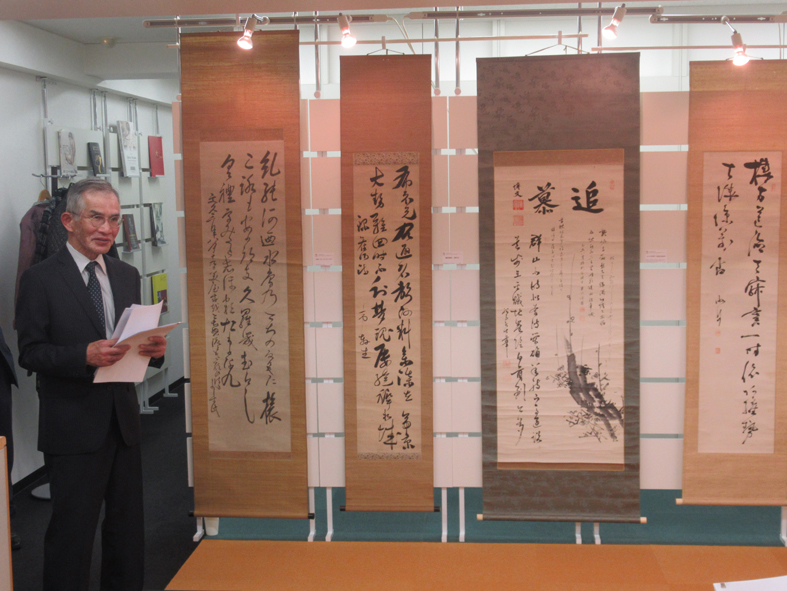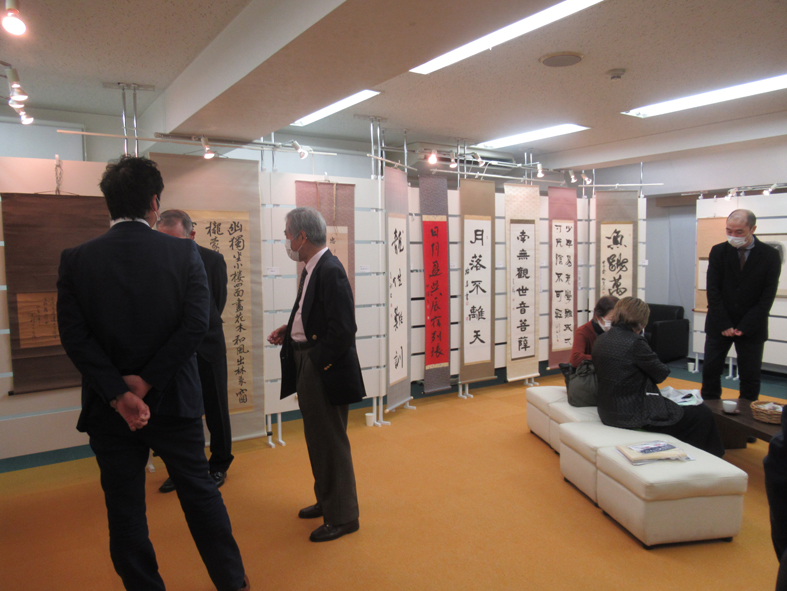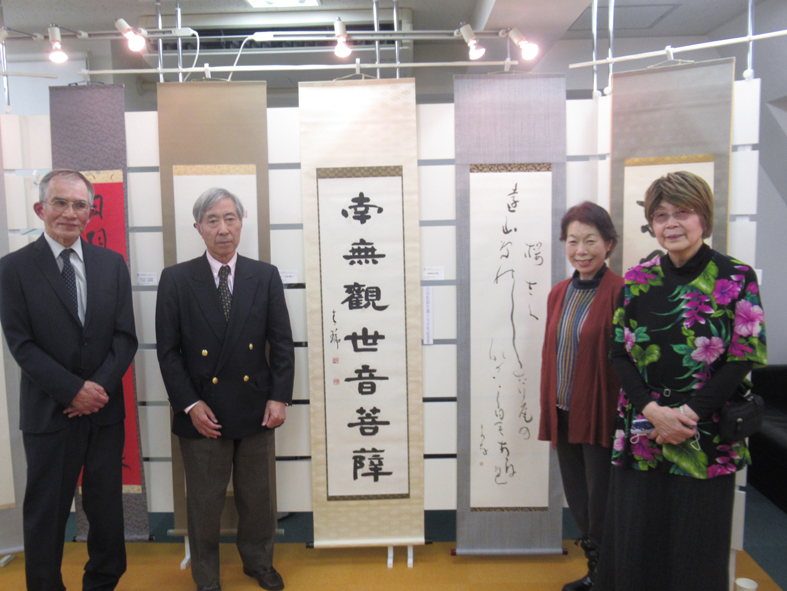-In Commemoration of the 190th Anniversary of Shoin Yoshida-
Art Education Exhibition “Manabiya”: Exploring Calligraphies of End of Edo Period and Contemporary Art
- 2020.07.02
- Activity
Art Education Exhibition “Manabiya” was held at Oedo Nihonbashi Gallery in two sessions: April 18 – May 1 and May 9-22, 2020. Mr. Nobutoshi Akao, Senior Advisor of Geibun Association, made opening remarks.

Mr. Akao’s Opening Remarks
This exhibition consists of calligraphies and ink brush paitings by the patriots of the end of the Edo period and Japanese contemporary art works.
This is the 4th exhibition of this kind, with the first one having taken place in 2017, in commemoration of the 150th anniversary of Meiji Restoration.
It was 150 years ago when the transition occurred from the era of the Tokugawa Shogunate to Meiji Era when the restoration of imperial rule took place in Nijo Castle in Kyoto.
This is normally taught in history classes of Japanese elementary and junior high schools, so that this exhibition is meaningful from such educational stand point, as well.
This kind of exhibition, collaborating contemporary art works with those of the end of the Edo period, is getting very difficult to organize nowadays. Fortunately, Mr. Hashimoto, who is a senior member of the Organization called “Ryoma Shachu,” has been kindly cooperating with our exhibition. Mr. Hashimoto has a collection of many original copies of the works of these important people such as Ryoma Sakamoto, Hirofumi Ito and Takamori Saigo. He says that the collaboration of works of the end of the Edo period and those of modern time is very interesting. This is one of the reasons he collaborates with us.
These works were exhibited both at the House of Representatives’ Kensei Kaikan and Edo Tokyo Museum for the 150th Anniversary of Meiji Restoration.
They were very big exhibitions and our Oedo Nihonbashi Gallery exhibition followed them in exhibiting some of these works.
In addition to such collaboration, Geibun Association has been sending messages how essential and wonderful art is for children’s education by organizing art exhibitions and children’s art session in collaboration with Nikko Toshogu Shrine.
We in Geibun Association would be extremely grateful if Japanese artists will continue to cooperate with us by exhibiting their great artworks in our future endeavor as well

Gallery Talk by Mr. Munakata, Oriental Art Advisor, Geibun Association
The Meiji Restoration, which is a great turning point of Japan, is not only given an great importance in Japan’s history text books, but also occupies an important weight in the history of art such as calligraphy and ink brush painting, which I have specialized in. Also, it is often the theme of history dramas of NHK (Japan Broadcasting Corporation). I would like to proceed with those points in mind.
First, the ink brush painting by Genzui Kusaka. It is certainly worth appreciating his work because he is said to have been the most brilliant among Shoin Yohida’s students and had prominent talent of ink brush painting.
Teijiro Akizuki was very brave and a deep thinker, who bravely thought about the future of Japan with Shoin Yoshida in Yamaguchi Prefecture, although he was from Fukushima.
Next, I would like to introduce the collection of messages for Shoin Yoshida by his students.
Ryoma Sakamoto drew ink brush painting admiring Shoin as a master of mind, and Hirofumi Ito seemed to have written the letters, which could be taken as the title of the message board.
The elegant calligraphies of Shinsaku Takasugi, Chouu Sugi and Moto Nomura demonstrate their deep respect and appreciation for Shoin.
Kaishu Katsu was not Shoin’s student, nevertheless he must have been attracted by Shoin’s personal magnetism.
And then, the calligraphy of Shinsaku Takasugi is beautiful, in sharp contrast to his character.
I feel that Shozan Sakuma is a genius for calligraphy and he might have had more power to change the world than Ryoma Sakamoto.
Lastly, Matushu, a painter of Kano School, painted portrait of Shoin, which is very rich in color, reflecting the feeling of Shoin’s farewell poem.
This concludes my Gallery Talk. Please, allow me for being brief, taking into account the currentCOVID-19 pandemic.




